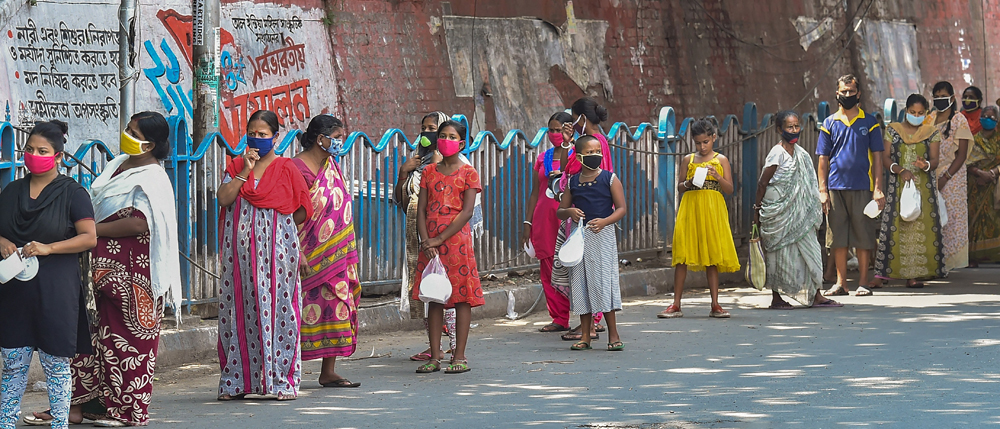The Mamata Banerjee government on Friday released a letter it had sent to the Centre on Thursday rejecting the Union health ministry’s claim of 10 Bengal districts being red zones. The letter asserted that the state had just four such districts.
Bengal health secretary Vivek Kumar’s letter to Union health secretary Preeti Sudan was sent hours after the Centre had published a nationwide list of 130 red zones, including 10 in Bengal.
Sudan too had written to all the chief secretaries on Thursday suggesting the colour-coding of districts was a “dynamic” process open to constant revisions, and that the criteria for the classifications had been widened to include parameters such as the extent of testing.
Before Kumar’s letter was released on Friday afternoon, Sudan’s letter was circulating on social media.
Kumar’s letter highlighted that a presentation made on Thursday afternoon at a videoconference between Union cabinet secretary Rajiv Gauba and all the state governments had shown 10 Bengal districts as red zones.
“This is an erroneous assessment,” Kumar wrote. “Based on the current parameters of Government of India for categorisation of areas for Covid-19, the districts in the red zone are only four: Calcutta, Howrah, North 24-Parganas and East Midnapore.”
He said these four districts had so far reported 821 Covid-19 cases, Calcutta alone accounting for 489. He added that a “correct” colour classification of Bengal’s districts had been attached with the letter.
This “correct” classification put 11 districts in the orange zone, with a combined total of 110 Covid-19 cases. These are Kalimpong, Jalpaiguri, Murshidabad, Nadia, Darjeeling, East and West Burdwan, West Midnapore, Malda, Hooghly and South 24-Parganas.
The Centre's list had categorised Kalimpong, Jalpaiguri, Darjeeling, Malda, South 24-Parganas and West Midnapore as red.
Trinamul Rajya Sabha MP Santanu Sen said Kalimpong had reported seven cases, none of them after April 2, while Jalpaiguri had reported five cases, and none since April 4.
'So these two are actually on the verge of turning green from orange. How were they classified as red?' said Sen, a senior physician and former president of the Indian Medical Association, and currently the secretary of its Bengal chapter.
While many in the Bengal government agreed with the state’s stand on Kalimpong and Jalpaiguri, some said the state’s classification of some of the other districts as orange needed to be analysed further.
“The categorisation of Kalimpong and Jalpaiguri as red zones is highly debatable,” a state government source said. But the data about districts such as South 24-Parganas, Hooghly and West Midnapore should be analysed further, the source added.
Kumar’s letter itself said South 24-Parganas had reported the latest of its 25 patients on April 28, Hooghly the latest of its 31 on April 30 and West Midnapore the last of its 12 cases on April 28.
“Besides, in her letter, Sudan had indicated that the parameters for the zone classifications were being changed. The extent of testing is a parameter now and Bengal is among the worst five states on that count,” the source said.
While the Centre and the state had on Thursday afternoon agreed on Bengal’s eight green-zone districts -- Alipurduar, Cooch Behar, North and South Dinajpur, Birbhum, Bankura, Purulia and Jhargram --Alipurduar and Birbhum had by late evening recorded their first Covid-19 cases, throwing their green-zone status into jeopardy.
Central guidelines issued last month had said a red zone would be reclassified as an orange zone if it reported no new cases for 14 days. Another 14 days without new cases would turn it into an infection-free green zone.
On Thursday, Sudan wrote that a district would be classified as a green zone if it had no confirmed cases at all or had reported no cases for 21 days.
However, she added: “The districts were earlier designated as hotspots/red zones, orange zones and green zones primarily based on the cumulative cases reported and the doubling rate.
“Since the recovery rates have gone up, the districts are now being designated across various zones duly broad-basing the criteria. This classification is multi-factorial and takes into consideration incidence of cases, doubling rate, extent of testing and surveillance feedback.”
Sudan’s letter addressed the objections raised by a few states to some of the classifications.
“Some states have raised issues on inclusion of certain districts in red-zone, I would like to highlight that this is a dynamic list. The list will be revised on a weekly basis or earlier and communicated to states for further follow-up action,” she wrote.
Sudan underscored the need to identify the pockets that need critical intervention and reminded the states to adhere to the already communicated containment action plan.
The plan, she wrote, includes stringent perimeter control; the establishment of clear entry and exit points; prevention of movement except to seek relief in medical emergencies or to avail essential goods and services; prevention of unchecked influx of people; recording of arrivals and follow-ups on them; house-to-house surveillance by special teams; testing of all cases according to sampling guidelines; contact-tracing; and clinical management of all confirmed cases.











